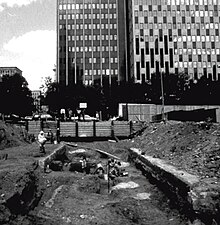Things in Bold: Things I have supplied links for/cited and or edits I have made to the text for clarification
After the English took over New Amsterdam in 1664, they changed the name to New York (after the Duke of York) and changed the rules governing slavery in the colony. Some 40 percent of the small population was in bondage.[1] The new slavery rules[2] were more harsh and restrictive than those of the Dutch, and rescinded many of the former rights and protections of slaves, such as the prohibition against arbitrary physical punishment.
Plan:
Add a paragraph or two to the site studies section about the cultural ties found by archeologist during excavation. This will help clarify the the info that is already there. (adding a total of 3 citations here and an image or two)
Link the actual excavation reports which as of the moment are not there.
In 1817, the New York legislature granted freedom to all children born to slaves after July 4, 1799 under the Gradual Emancipation Act[3], with total abolition of slavery to take effect on July 4, 1827. July 4 is now known as New York's Emancipation Day, more than 10,000 slaves were freed in New York State with no financial compensation to their former owners. Blacks paraded in New York City to celebrate.
In October 1991, the United States Government agency, the General Services Administration (GSA) announced the discovery (or rediscovery) of intact burials during an archaeological survey and excavation for the construction of a new $275 million federal office building planned at 290 Broadway between Reade and Chambers Streets. The building was to be later known as the Ted Weiss Federal Building, named for deceased U.S. Representative (Congressman) Ted Weiss from New York. Under section 106 of the National Historic Preservation Act[4], the federal government is required to identify and assess the historic presence of a site prior to building on the land. The agency had done an environmental impact statement (EIS) prior to purchase of the site, but the archaeological survey had predicted that human remains would not be found because of the long history of urban development in that area.
As a result of public engagement, the Howard University team identified four questions which the community hoped to have answered from studies of the remains:
- "cultural background and origins of the burial population;
- the cultural and biological transformations from African to African-American identities;
- quality of life brought about by enslavement in the Americas; and
- modes of resistance to enslavement."
Before the erection of the monument, the burial ground had endured an immense amount of abuse. Archeologists found a substantial amount of industrial waste and ceramics while excavating the site[5]. Archaeologists concluded that burial ground was being used as a dumpsite by Europeans during the 18th century. The burial ground was also subject to grave robbing and looting during this time. In April of 1788, the Doctor Riot[6] spread throughout New York City. The riots were led by physicians that would steal corpses from graves to study them as the supply of medical corpses was extremely low. Many of these stolen corpses came from the African Burial Ground. There was speculation that the grounds were not only being looted but were overcrowding due to the burial of unclaimed bodies in the place of the stolen remains. In response, the burial ground was closed in April of 1794.

 | This is a user sandbox of JWi1son. You can use it for testing or practicing edits. This is not the sandbox where you should draft your assigned article for a dashboard.wikiedu.org course. To find the right sandbox for your assignment, visit your Dashboard course page and follow the Sandbox Draft link for your assigned article in the My Articles section. |
- ^ Spencer P.M. Harrington, "Bones and Bureaucrats", Archaeology, March/April 1993. Retrieved 11 February 2012
- ^ "Slave Laws in British Colonial New York, 1664—1731 · SHEC: Resources for Teachers". herb.ashp.cuny.edu. Retrieved 2020-09-27.
- ^ "Digital Collections : Text : An Act for the gradual abolition of slavery [NYSA_13036-78_L1799_Ch062]". digitalcollections.archives.nysed.gov. Retrieved 2020-10-08.
- ^ "Section 106: National Historic Preservation Act of 1966". www.gsa.gov. Retrieved 2020-10-08.
- ^ U.S. General Services Administration. “The New York African Burial Ground: unearthing the African Presence in colonial New York.” vol. 1, 2009, p. 371, https://www.nps.gov/afbg/learn/historyculture/upload/downVol1-Part1-The-Skeletal-Biology-of-the-NYAGB.pdf. Accessed 10 November 2020
- ^ "1788 doctors' riot", Wikipedia, 2019-12-14, retrieved 2020-11-10